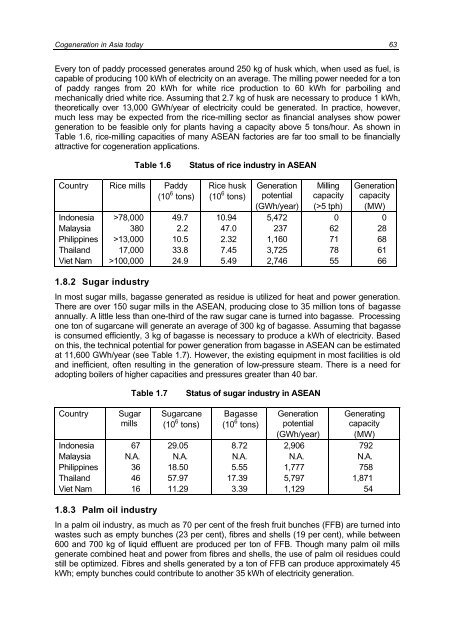part 1: overview of cogeneration and its status in asia - Fire
part 1: overview of cogeneration and its status in asia - Fire
part 1: overview of cogeneration and its status in asia - Fire
You also want an ePaper? Increase the reach of your titles
YUMPU automatically turns print PDFs into web optimized ePapers that Google loves.
Cogeneration <strong>in</strong> Asia today 63<br />
Every ton <strong>of</strong> paddy processed generates around 250 kg <strong>of</strong> husk which, when used as fuel, is<br />
capable <strong>of</strong> produc<strong>in</strong>g 100 kWh <strong>of</strong> electricity on an average. The mill<strong>in</strong>g power needed for a ton<br />
<strong>of</strong> paddy ranges from 20 kWh for white rice production to 60 kWh for parboil<strong>in</strong>g <strong>and</strong><br />
mechanically dried white rice. Assum<strong>in</strong>g that 2.7 kg <strong>of</strong> husk are necessary to produce 1 kWh,<br />
theoretically over 13,000 GWh/year <strong>of</strong> electricity could be generated. In practice, however,<br />
much less may be expected from the rice-mill<strong>in</strong>g sector as f<strong>in</strong>ancial analyses show power<br />
generation to be feasible only for plants hav<strong>in</strong>g a capacity above 5 tons/hour. As shown <strong>in</strong><br />
Table 1.6, rice-mill<strong>in</strong>g capacities <strong>of</strong> many ASEAN factories are far too small to be f<strong>in</strong>ancially<br />
attractive for <strong>cogeneration</strong> applications.<br />
Country Rice mills Paddy<br />
(10 6 tons)<br />
Indonesia<br />
Malaysia<br />
Philipp<strong>in</strong>es<br />
Thail<strong>and</strong><br />
Viet Nam<br />
>78,000<br />
380<br />
>13,000<br />
17,000<br />
>100,000<br />
1.8.2 Sugar <strong>in</strong>dustry<br />
Table 1.6 Status <strong>of</strong> rice <strong>in</strong>dustry <strong>in</strong> ASEAN<br />
49.7<br />
2.2<br />
10.5<br />
33.8<br />
24.9<br />
Rice husk<br />
(10 6 tons)<br />
10.94<br />
47.0<br />
2.32<br />
7.45<br />
5.49<br />
Generation<br />
potential<br />
(GWh/year)<br />
5,472<br />
237<br />
1,160<br />
3,725<br />
2,746<br />
Mill<strong>in</strong>g<br />
capacity<br />
(>5 tph)<br />
0<br />
62<br />
71<br />
78<br />
55<br />
Generation<br />
capacity<br />
(MW)<br />
0<br />
28<br />
68<br />
61<br />
66<br />
In most sugar mills, bagasse generated as residue is utilized for heat <strong>and</strong> power generation.<br />
There are over 150 sugar mills <strong>in</strong> the ASEAN, produc<strong>in</strong>g close to 35 million tons <strong>of</strong> bagasse<br />
annually. A little less than one-third <strong>of</strong> the raw sugar cane is turned <strong>in</strong>to bagasse. Process<strong>in</strong>g<br />
one ton <strong>of</strong> sugarcane will generate an average <strong>of</strong> 300 kg <strong>of</strong> bagasse. Assum<strong>in</strong>g that bagasse<br />
is consumed efficiently, 3 kg <strong>of</strong> bagasse is necessary to produce a kWh <strong>of</strong> electricity. Based<br />
on this, the technical potential for power generation from bagasse <strong>in</strong> ASEAN can be estimated<br />
at 11,600 GWh/year (see Table 1.7). However, the exist<strong>in</strong>g equipment <strong>in</strong> most facilities is old<br />
<strong>and</strong> <strong>in</strong>efficient, <strong>of</strong>ten result<strong>in</strong>g <strong>in</strong> the generation <strong>of</strong> low-pressure steam. There is a need for<br />
adopt<strong>in</strong>g boilers <strong>of</strong> higher capacities <strong>and</strong> pressures greater than 40 bar.<br />
Country Sugar<br />
mills<br />
Indonesia<br />
Malaysia<br />
Philipp<strong>in</strong>es<br />
Thail<strong>and</strong><br />
Viet Nam<br />
Table 1.7 Status <strong>of</strong> sugar <strong>in</strong>dustry <strong>in</strong> ASEAN<br />
67<br />
N.A.<br />
36<br />
46<br />
16<br />
1.8.3 Palm oil <strong>in</strong>dustry<br />
Sugarcane<br />
(10 6 tons)<br />
29.05<br />
N.A.<br />
18.50<br />
57.97<br />
11.29<br />
Bagasse<br />
(10 6 tons)<br />
8.72<br />
N.A.<br />
5.55<br />
17.39<br />
3.39<br />
Generation<br />
potential<br />
(GWh/year)<br />
2,906<br />
N.A.<br />
1,777<br />
5,797<br />
1,129<br />
Generat<strong>in</strong>g<br />
capacity<br />
(MW)<br />
792<br />
N.A.<br />
758<br />
1,871<br />
54<br />
In a palm oil <strong>in</strong>dustry, as much as 70 per cent <strong>of</strong> the fresh fruit bunches (FFB) are turned <strong>in</strong>to<br />
wastes such as empty bunches (23 per cent), fibres <strong>and</strong> shells (19 per cent), while between<br />
600 <strong>and</strong> 700 kg <strong>of</strong> liquid effluent are produced per ton <strong>of</strong> FFB. Though many palm oil mills<br />
generate comb<strong>in</strong>ed heat <strong>and</strong> power from fibres <strong>and</strong> shells, the use <strong>of</strong> palm oil residues could<br />
still be optimized. Fibres <strong>and</strong> shells generated by a ton <strong>of</strong> FFB can produce approximately 45<br />
kWh; empty bunches could contribute to another 35 kWh <strong>of</strong> electricity generation.









